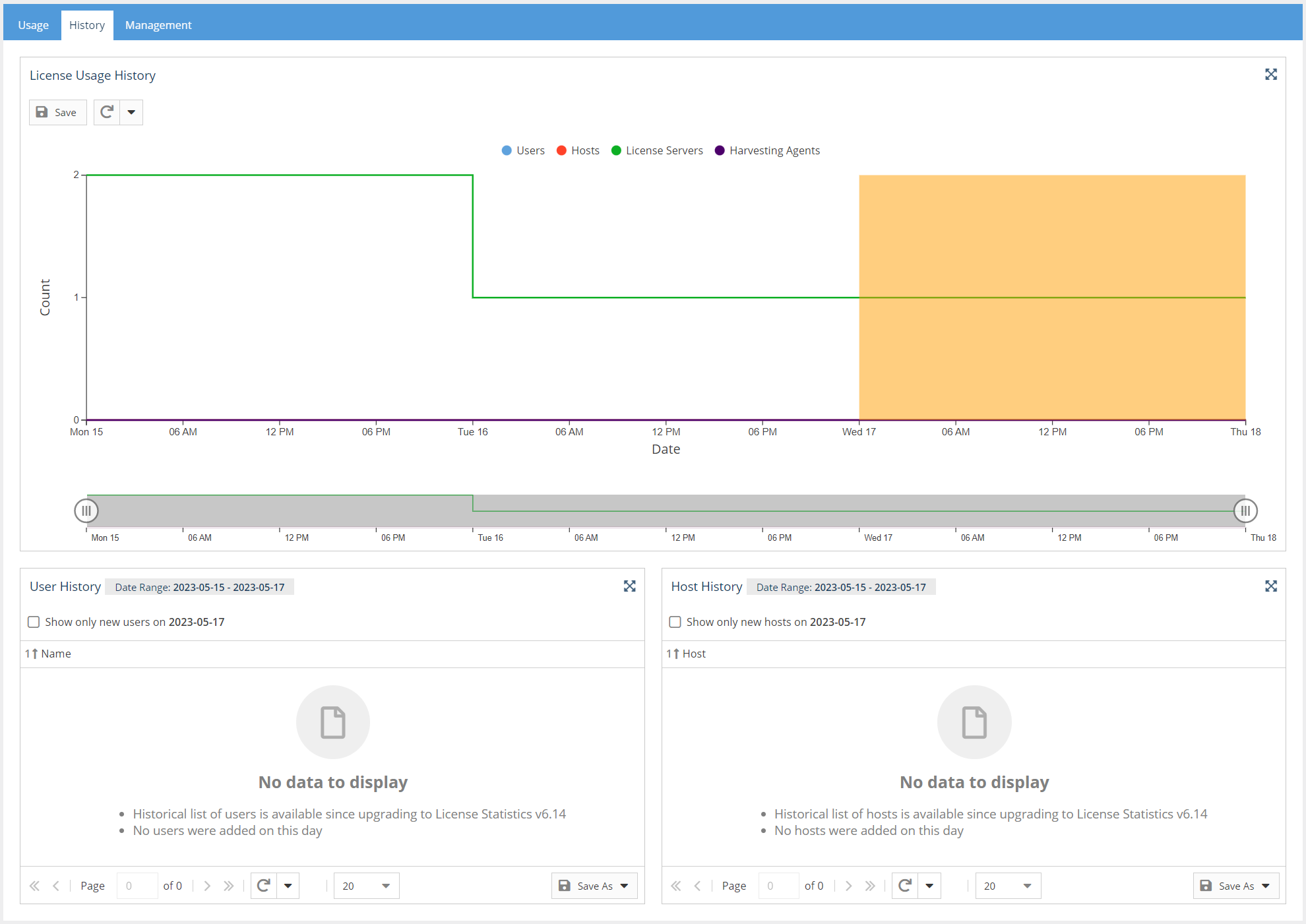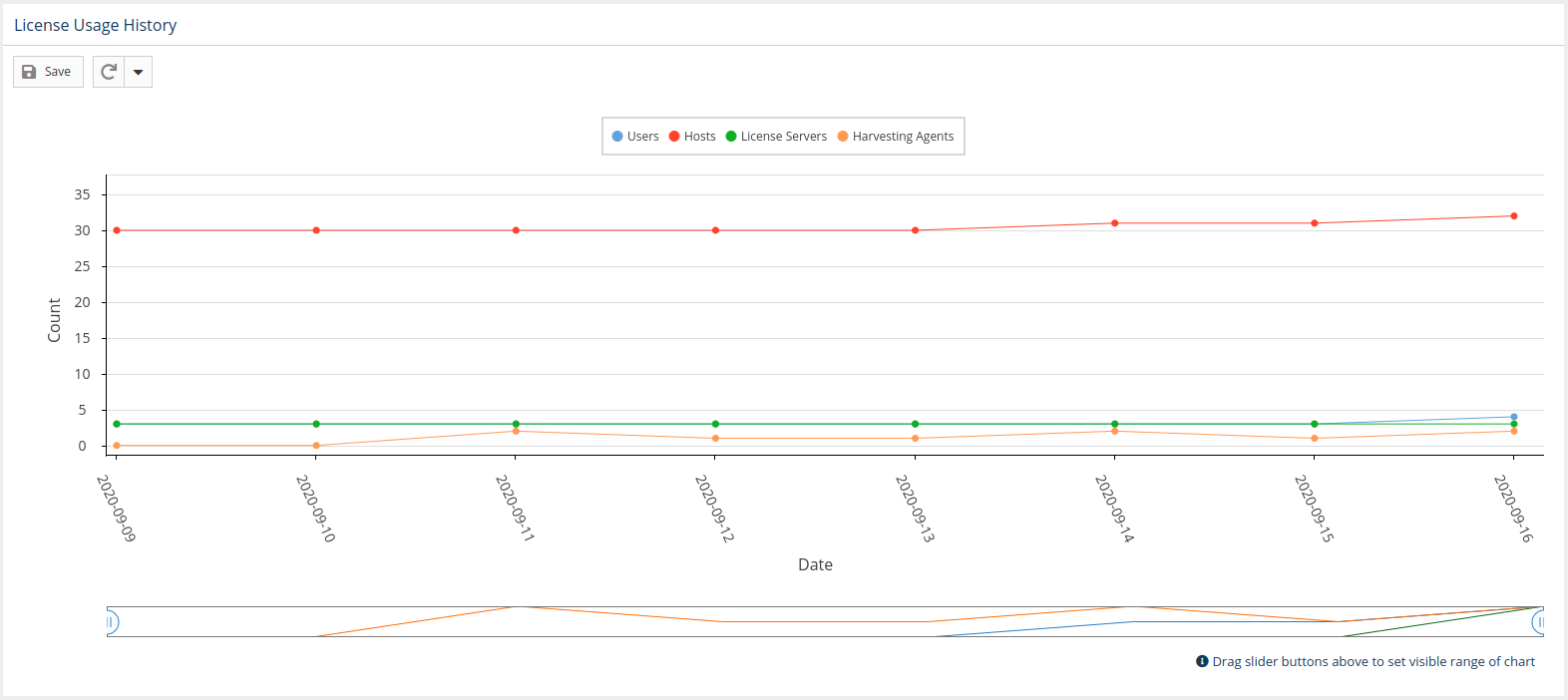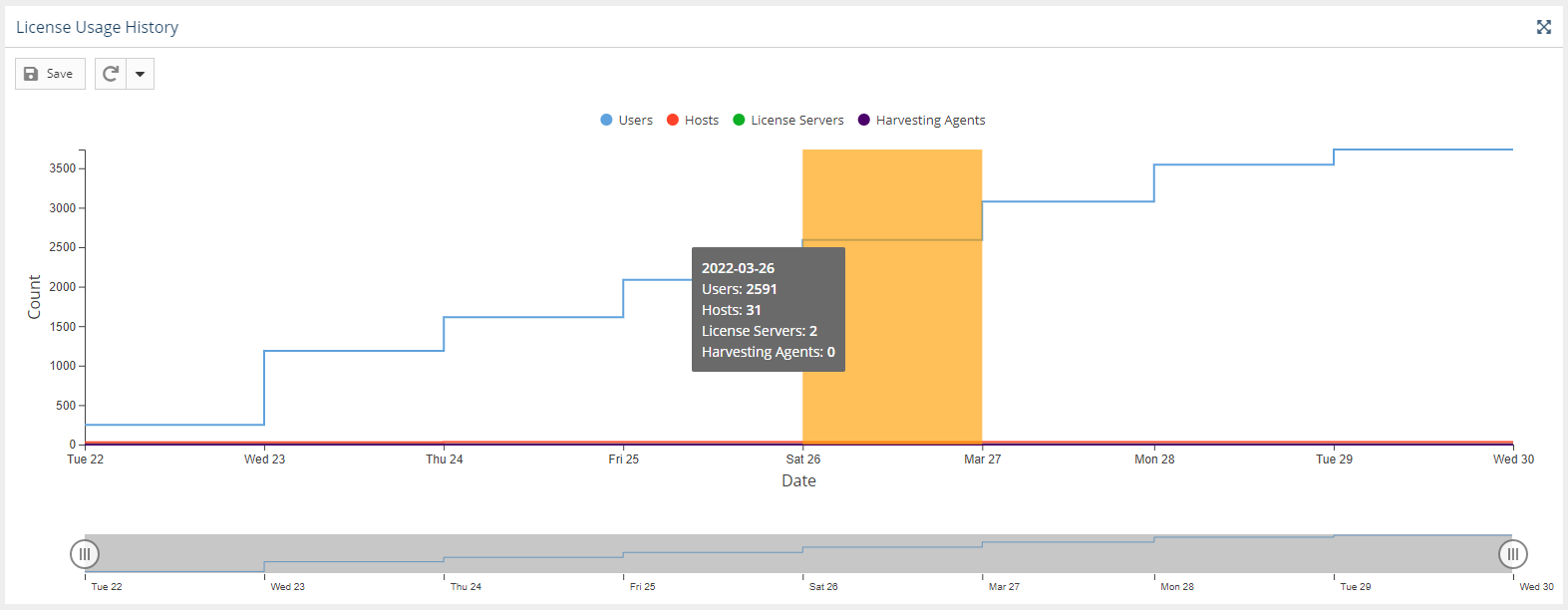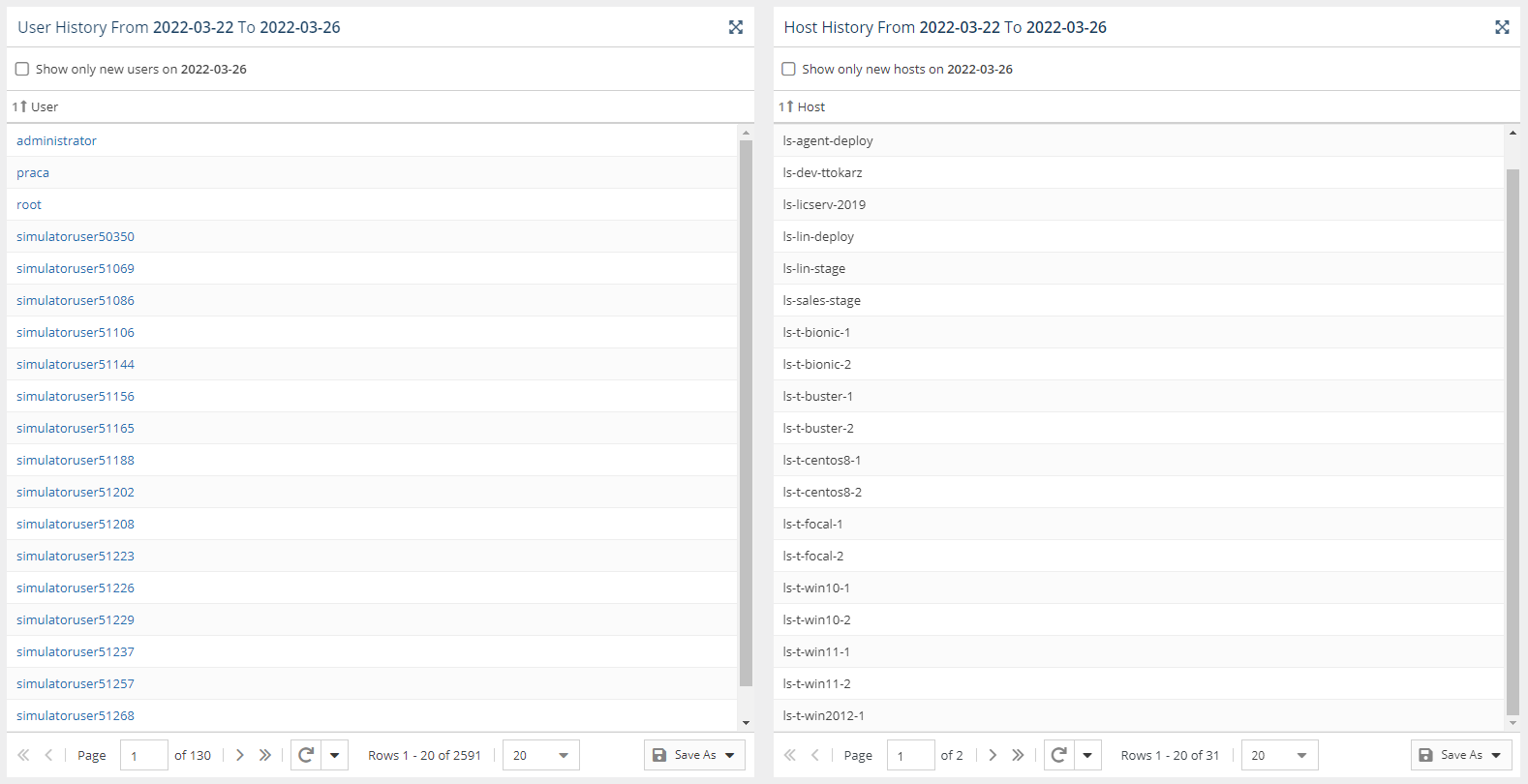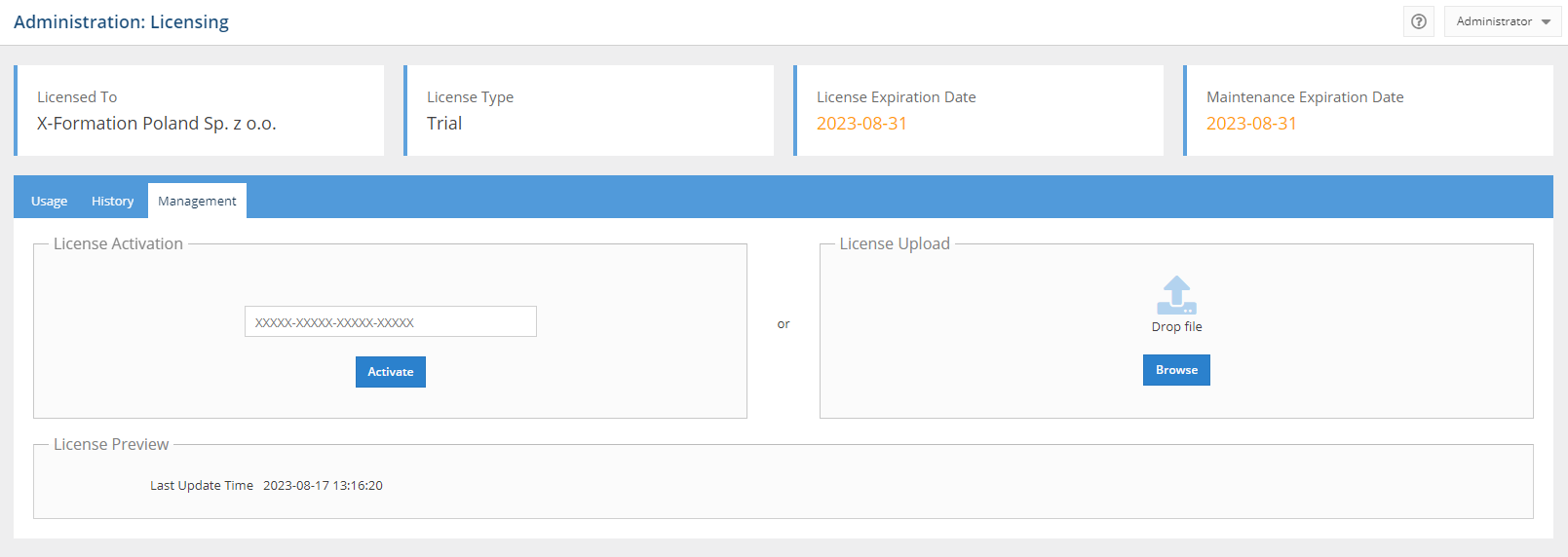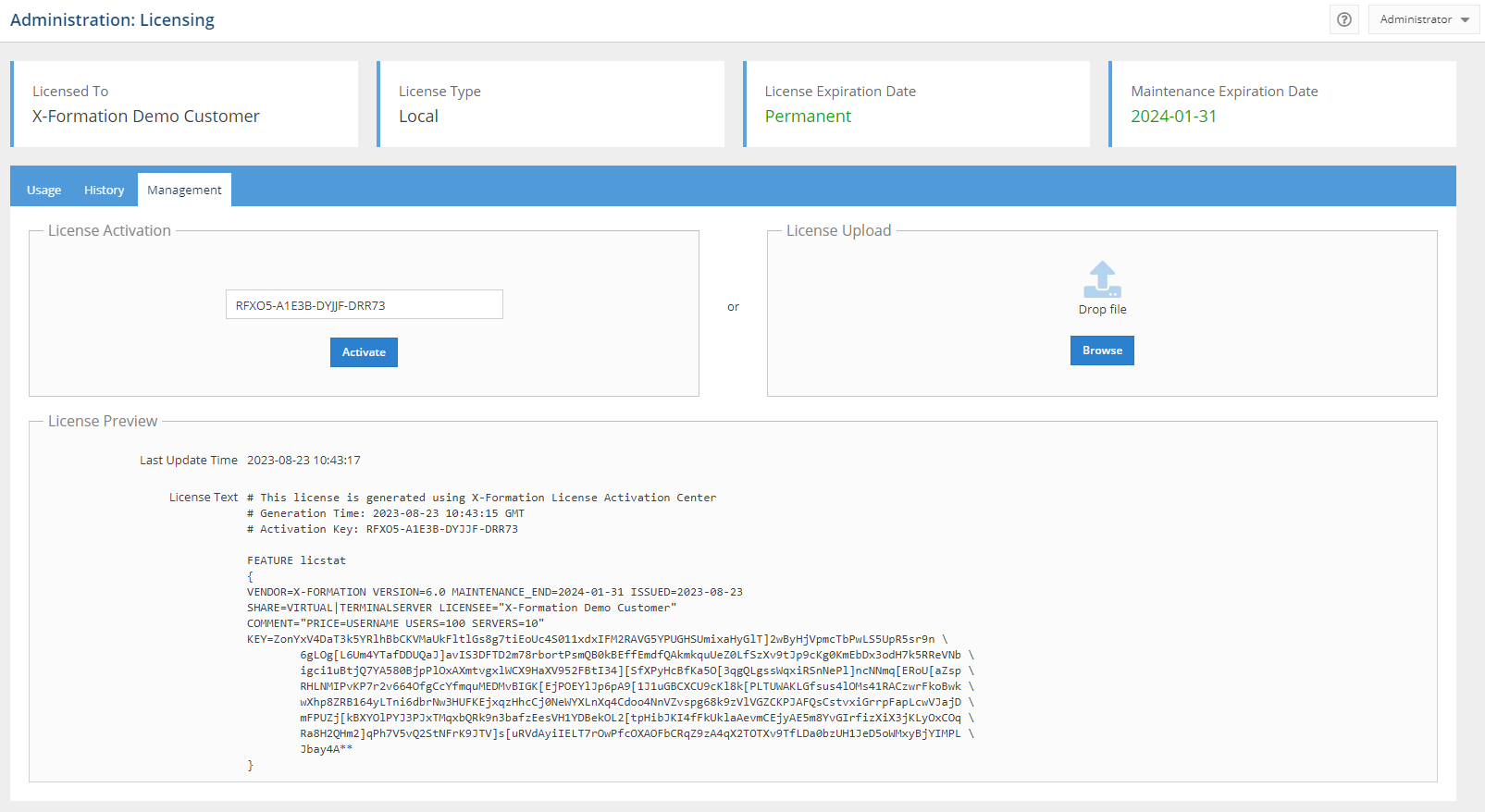| The information on this page refers to License Statistics v6.19 or newer, which improved the layout of the Management tab. If you are using an earlier version, please refer to the documentation for earlier versions. |
| Info |
|---|
The information given on this page applies to both Licensing Model 2013 and Licensing Model 2019. This page covers information about where to look for licensing details in the License Statistics v6.x UI. For complete details about each of the licensing models, see: For information on switching from Licensing Model 2013 to Licensing Model 2019, see License Transition. |
The Licensing page under the Administration section is divided into three tabs:
| Contains gauge charts that show current usage of your License Statistics license | |
| History | Contains reports that show historical usage of your License Statistics license |
| Management | Contains options for managing your License Statistics license, including activation |
Using each of these tabs is described below.
| Anchor | ||||
|---|---|---|---|---|
|
To see license usage information, click the Usage tab at the top of the Licensing page.
When license usage is within your license limits, the gauge charts will be green, as illustrated below.
You can easily see when your license limits are exceeded or nearing threshold (90% and above), indicated by red in the gauge charts, as illustrated below for the Users and License Servers gauges.
The Hosts gauge reports the number of hosts monitored for the entire database. The Total value is 125% of the Users gauge's Total value, which is the threshold unless a High Performance Computing (HPC) license is being used.
If an HPC license is in use, the threshold on allowed number of Hosts is lifted, and the Hosts information will look similar to the following illustration.
If there are no Harvesting Agents included in the license, the Harvesting Agents information will indicate "No License," as shown in the above illustration.
| Info |
|---|
For Licensing Model 2013:
|
Anchor History History
History
| History | |
| History |
To see license usage history information, click the History tab at the top of the Licensing page.
This tab contains a License Usage History chart and User History and Host History grids.
License Usage History chart
The License Usage History chart in the Licensing page reports historical usage of the License Statistics license.
Data is shown up through the current day by default. To see details for a specific time period, click on the end-date for the time period in the chart. (Days will be highlighted as you move your mouse over the chart.)
You can limit the information to only the users/hosts who are new (were not included in usage for previous days) by toggling on Show only new users/hosts.
The information shown in the License Usage History chart depends on your licensing model, as described below.
Licensing Model 2019
The License Usage History chart for the Licensing Model 2019 includes the following information.
- Number of all users in the database up through the selected date
- Number of all hosts in the database up through the selected date
- Number of maximum concurrent license servers in each day
- Number of Harvesting Agents in each day
Licensing Model 2013
The License Usage History chart for Licensing Model 2013 includes the following information.
- Number of users or user-hosts for the last 14 days
- Number of maximum concurrent license servers in each day
User History grid
The User History grid displays license usage history up to the date selected in the License Usage History chart (or the current date if none is selected).
The information shown in the User History grid depends on your licensing model, as described below.
Licensing Model 2019
For the Licensing Model 2019, separate User History and Host History grids display license usage history from the beginning of the database to the selected date (current date by default).
Licensing Model 2013
For the Licensing Model 2013, a User History grid with user-host pairs displays license usage history for 14 days (by default) prior to the selected date (or current date if none is selected) up through the selected date.
| Anchor | ||||
|---|---|---|---|---|
|
To see license management options, click the Management tab at the top of the Licensing page.
This tab contains three sections to help you manage your License Statistics license, as described below.
License Activation
Under the License Activation section, the Activation Key field displays the key currently in use, or if the license has no associated activation key (as is the case for trial licenses), a series of X's is displayed as a placeholder for the key.
- To activate a new license (for example, after a new license purchase), enter the key in the Activation Key field and click Activate.
- To reactivate the same license (for example, after extending your maintenance or after X-Formation has changed your license parameters), click Activate without changing the Activation Key field contents.
The new activation will replace the previously used license.
License Upload
The License Upload section lets you upload a license file directly in cases where activation is not possible or is not preferable; for example:
- Due to no internet connection on the License Statistics host, the license was activated on a different machine or downloaded from the License Activation Center end-user portal
- The license already exists as a file
- You obtained a license file from X-Formation Support or Sales
The new license upload will replace the previously used license.
License Preview
The License Preview section shows the date and time that the license was last updated, and after a new license has been activated/uploaded, displays the content of the current license (for informational purposes only).
License usage notifications
A popup notification will alert you if you are reaching your licensed limit for users/hosts. The notification is activated at 80%, 90%, and 95% usage thresholds, as those thresholds are exceeded. For example, after exceeding the 80% threshold, a notification similar to the following will popup on the screen:
You can:
- Click OK to dismiss the notification for the current threshold level for 1 day.
- Click Dismiss to dismiss the notification for the current threshold level for 7 days.
A new notification will appear if a higher threshold is exceeded, regardless of dismissal. For example, if you dismiss a notification for reaching the 80% threshold, a new notification will appear within that dismissal period if the usage exceeds 90%.
License Statistics considers a "user" to be a unique person or a machine that is accessing the monitored applications. The user count is not based on the number of applications being used, but rather on a) the number of users and b) the number of hosts (machines) the users are running applications from; that is, a unique user/hostname combination.
Realtime usage
You can see a realtime user count in the Realtime User Count report's Daily Users column. Note the following for realtime usage data:
...
Imported usage
You can review the import log to obtain a user count for imported data. Note the following for imported usage data:
- The total users count includes every user that used a license that is included in the import log, regardless of the date of usage. This differs from realtime user count history, which only counts users who used a license within the past 14 days (as described above).
- The total server count is the number of servers for which data was imported during the past 3 months. Any servers for which data was imported more than 3 months ago are not included in the total server count.
Examples of user count
Users are counted as described in the following examples.
- If User1 runs one application using only HostA, that user is counted as one user.
- If User1 runs two or more applications, still using only HostA, that user is still counted as one user.
- If User1 runs an application from HostA and HostB, either simultaneously or at separate times, User1 is counted as two users.
For applications that use more than one machine (for example, EDA applications), user count is commonly as follows; however, ask your application vendor how their licensing works in such cases.
- If User1 uses his own computer to start EDA_ApplicationA on license servers ServerA and ServerB, thereby consuming a license for User1's computer and for the two servers, this will result in a user count of 3 (User1, ServerA and ServerB are each considered "users" of the application).
...



